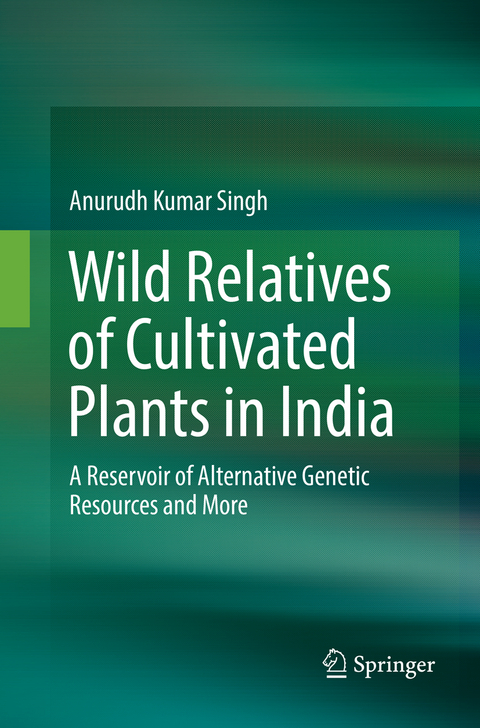
Wild Relatives of Cultivated Plants in India
Springer Verlag, Singapore
978-981-13-5323-9 (ISBN)
Dr. Anurudh K. Singh was educated at Aligarh Muslim University (1962-1966), Patna University (1969-1972), the Max Planck Institute, Koln, Germany (1986-1987), and Cornell University, Ithaca, USA (1994-1995) has been interested in the wild relatives of crop species since the beginning of his career. For his Ph.D., he worked on their collection, conservation and conducted cytogenetic studies to trace the phylogenetic relationships between wild species related to Cucurbit vegetable crop species. More significantly, from 1978-1997, while at International Crops Research Institute for the Semi-Arid Tropics (ICRISAT), he was involved in a project on utilizing wild Arachis to genetically improveme cultivated groundnut, and successfully incorporated foliar diseases resistance and other desirable traits from several wild diploid Arachis species. Later, he became involved in the collection and conservation of groundnut germplasm, including wild Arachis species. From 1998-2 008, as National Gene Bank curator and head of the Germplasm Conservation Division at the National Bureau of Plant Genetic Resources (NBPGR), New Delhi, he was responsible for the ex-situ conservation of crop germplasm with special emphasis on wild relatives of cultivated species. As member secretary of the Germplasm Registration Committee, Indian Council of Agricultural Research (ICAR), he registered a number of wild relatives of crops; and as member secretary of the Task Force for Protection of Plant Varieties and Farmers’ Rights (PPV & FR), he was involved in the identification of agrobiodiversity hotspots in India and production of the first inventory of cultivated species and their wild relatives. For these contributions he received the “The CGIAR Chairman’s Excellence in Science Award” for “Outstanding Locally Recruited Scientist” (1997). He was awarded a fellowship of The National Academy of Sciences, India (2001) and of the National Academy of Agricultural Sciences, India (2004). He has more than 210 scientific publications to his credit, including four books.
Chapter 1. Introduction.- Part 1. Wild Relatives.- Chapter 2. Defining Wild Relatives.- Chapter 3. Importance of Wild Relatives as Genetic Resource and Otherwise.- Part 2. Wild Relatives Distribution and Diversity in Different Crop Groups.- Chapter 4. Cereals.- Chapter 5. Grain Legumes.- Chapter 6. Oilseeds.- Chapter 7. Fiber Crops.- Chapter 8. Forages Crops.- Chapter 9. Vegetables.- Chapter10. Fruits and Nuts.- Chapter 11. Species and Condiments.- Chapter 12. Commercial Crops (sugarcane, tea, coffee, rubber etc.).- Chapter 13. Medicinal and Aromatic plants.- Chapter 14. Floriculture Crops.- Chapter 15. Agro-forestry.- Chapter 16. Cottage Industry Crops and Others (Bamboo, arrowroot, reetha etc.).- Part 3. Conservation of Wild Relatives.- Chapter 17. Classification of Wild Relatives to Facilitate Conservation and Gene Transfer.- Chapter 18. Collection Strategies.- Chapter 19.&nbs
p;Conservation Strategies.- Chapter 20. Breeding Strategies for Use.- Chapter 21. Future Perspective.
“The current book on ‘wild relatives of cultivated plants in India: a reservoir of alternative genetic resources and more’ is an intriguing description of the occurrence and distribution of around 958 wild species of cultivated plants in India … . The book will also serve as a template for documenting the occurrence and distribution of neglected and underutilized, wild crop relatives in megadiverse countries like China, Brazil, Indonesia, Malaysia, South Africa etc.” (Ajeet Singh and P. C. Abhilash, Genetic Resources and Crop Evolution, Vol. 65, 2018)
| Erscheint lt. Verlag | 13.12.2018 |
|---|---|
| Zusatzinfo | 17 Illustrations, color; 2 Illustrations, black and white; XIII, 309 p. 19 illus., 17 illus. in color. |
| Verlagsort | Singapore |
| Sprache | englisch |
| Maße | 155 x 235 mm |
| Themenwelt | Naturwissenschaften ► Biologie ► Botanik |
| Naturwissenschaften ► Biologie ► Genetik / Molekularbiologie | |
| Naturwissenschaften ► Biologie ► Ökologie / Naturschutz | |
| Weitere Fachgebiete ► Land- / Forstwirtschaft / Fischerei | |
| Schlagworte | Breeding strategies • Collection • conservation • plant genetic resources • wild relatives |
| ISBN-10 | 981-13-5323-9 / 9811353239 |
| ISBN-13 | 978-981-13-5323-9 / 9789811353239 |
| Zustand | Neuware |
| Haben Sie eine Frage zum Produkt? |
aus dem Bereich


